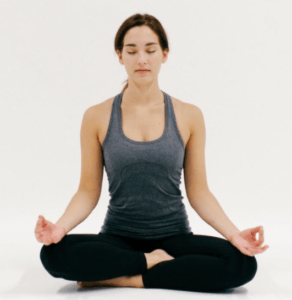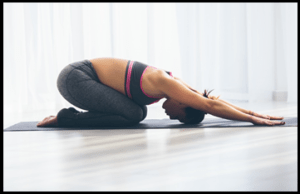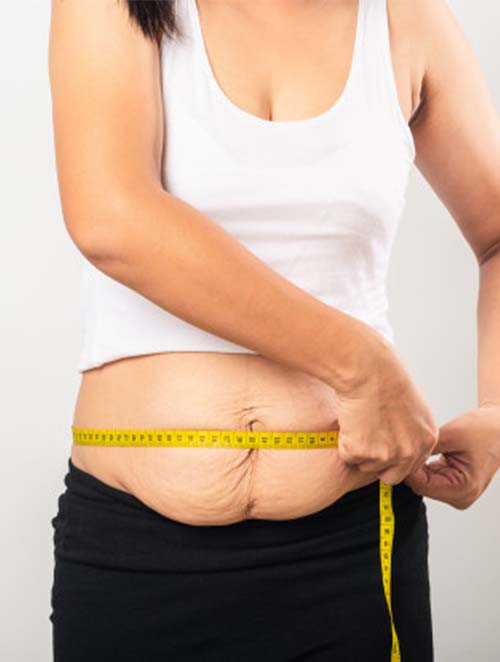Bouncing back with Yoga! Postpartum Yoga; A Long-Lasting Gift You Can Give Yourself!
 35014
35014

super easy
Delivering a baby can be grueling, demanding, exhaustive, and can take a toll on the mother’s body. During the pregnancy, the mother’s body works round the clock to make sure that things go all right, not only with the mother but also with the fetus. Her body wears out, goes through tremendous complications, wears and tears, and gets severely affected in the process. Delivering the baby doesn’t end all that, and complications persist for a few weeks and sometimes for a few months. But there are ways in which the mother can take care of herself after the delivery to ensure her health and weight complications. And one of the most important practices a mother can opt for is Yoga. Yoga can help a great deal and genuinely make a difference to the mother’s mind and the body after the delivery. This article is a humble attempt at MommyWize, to spread and share some essential information that can be helpful to the mothers out there and can bring a significant difference in their well beings after the grueling process of pregnancy that they have gone through recently. Following is the set of Postpartum Yoga practices that mothers can make include in their daily routine.
1. Bhastrika Pranayam
Since Pranayam is a set of deep breathing exercises, it can be started even after a few days of delivery. Bhastrika Pranayam is an excellent postpartum Yoga practice that mothers can opt for as an exercise in the postnatal period. It induces deep breathing and aids in better blood circulation. Mothers should make sure that less force or stress is applied to the body while practicing Bhastrika. Doing this Pranayam for about 5 minutes daily can help the mother strengthen her immune system, calm her mind whenever she feels disturbed or unsettled due to several delivery-induced changes in the body, and help feel better in an overall manner. Bhastrika also helps the mother to get better nutrition as the blood circulation gets significantly better due to deep breathing.
How to Do Bhastrika Pranayam –
1. Sit comfortably as depicted in the picture given above. 2. The moment you feel comfortable, start taking a deep breath and fill your lungs with air. 3. Now, release the breath after a few seconds as per your comfort. 5 seconds is a decent amount of time and is advisable in the initial stages of this practice. 4. Make sure your shoulders move the least to aid in deep and sound breathing 5. Now repeat the practice a few more times
2. Anulom Vilom –
 Another postpartum Yoga exercise that can be helpful for mothers shortly after delivery is Anulom Vilom. Anulom Vilom helps the mother manage hormonal imbalances in the body during the postnatal period. It also helps in the process of detoxification and aids in balancing the nervous system. Anulom Vilom also helps in enlivening the mood and helps the mother to get rid of anxiety and depression that can kick in in the postnatal period.
Another postpartum Yoga exercise that can be helpful for mothers shortly after delivery is Anulom Vilom. Anulom Vilom helps the mother manage hormonal imbalances in the body during the postnatal period. It also helps in the process of detoxification and aids in balancing the nervous system. Anulom Vilom also helps in enlivening the mood and helps the mother to get rid of anxiety and depression that can kick in in the postnatal period.
How to Do Anulom Vilom –
1. Sit comfortably as depicted in the picture given above 2. If you are willing to begin this exercise from the right nostril, then close the left one with your right thumb and inhale slowly filling up your lungs 3. Now, exhale slowly and in a controlled manner from the left nostril 4. It is crucial to focus on your breath and practice the technique in a controlled and steady way 5. Now practice this exercise for the next five minutes 6. Ensure that your back is aligned and shoulders are relaxed (stiffness of any kind in the body leads to ineffective and at times damaging practice of Yoga) while you are performing the practice of Anulom Vilom
3. Mula Bandha –
 Mula Bandha is an essential postpartum yoga for women who have recently delivered a baby. Though it isn’t very complicated and the chances of injuring or harming one’s body while practicing it is negligible, any kind of exercise physical exercise, including the kriya of Mula Bandha, must be started nearly after six to eight weeks of delivery. Six weeks is advisable in case of vaginal delivery and eight for the C-section one. Mula Bandha is a highly effective exercise for the pelvic floor. During the prenatal period, mothers can go through urine and gas leakage issues, which, most of the time, continue in the postnatal period as well. Mula Bandha helps to get rid of those problems by re-engaging with the pelvic floor, which has gone through a lot during pregnancy and delivery.
Mula Bandha is an essential postpartum yoga for women who have recently delivered a baby. Though it isn’t very complicated and the chances of injuring or harming one’s body while practicing it is negligible, any kind of exercise physical exercise, including the kriya of Mula Bandha, must be started nearly after six to eight weeks of delivery. Six weeks is advisable in case of vaginal delivery and eight for the C-section one. Mula Bandha is a highly effective exercise for the pelvic floor. During the prenatal period, mothers can go through urine and gas leakage issues, which, most of the time, continue in the postnatal period as well. Mula Bandha helps to get rid of those problems by re-engaging with the pelvic floor, which has gone through a lot during pregnancy and delivery.
How to Do Mula Bandha Yoga –
1. To begin Mula Bandha Yoga, you should start with exhalation and try to engage the pelvic floor consciously 2. Try to draw it upwards, towards your navel in a gradual manner. Make sure you do not rush into it 3. If you find yourself unable to access the pelvic floor, imagine it a particular space between the pubic bone and the tailbone 4. Try to explore this feeling by contracting the muscles you would use to stop the flow of urine midstream. 5. Then start contracting and holding the muscles around the anus and genitals 6. But eventually what you should be targeting is to be able to isolate and draw up the perineum, which lies between the anus and genitals 7. Make sure you breathe regularly and deeply. Do not hold your breath at any point of time while practicing this yoga
4. Setu Bandha Sarvangasana

Setu Bandh Sarvangasana, also called Bridge Pose is a wonderful pose for all the mothers who are in the postnatal period. Pregnancy and delivery can cause a great deal of discomfort in the spine and can tighten your hip flexors, shoulders, and especially the chest. Bridge pose can help in relieving all the tension and stress accumulated in those regions and can also aid in strengthening the lower body which has endured a lot during the past few months.
How to Do Bridge Pose –
1. Make sure you are comfortable and use a well-founded mat beneath you on which you shall perform this Yoga 2. Now, lie on your back and keep your knees bent and let your feet rest on the floor 3. Then, extend your arms along the floor with your palms facing the floor 4. This is the position you need to be just before you start practicing this Yoga 5. Press your feet and arms onto the floor and exhale as you lift your hips and your waist towards the roof 6. Try to stay in that in position for a few seconds and then slowly and steadily bring your body down on the floor 7. Repeat the exercise a few more times as per your comfort
5. Balasana
 Balasana is another effective Yogic exercise that relieves tension and stretches those areas of the body that go through a lot due to the physically knackering pregnancy and delivery, such as ankles, hips, and shoulders. Balasana also aids in digestion and helps in regulating your metabolic rate, which can get disturbed due to hormonal changes that occur in the body during the postnatal period.
Balasana is another effective Yogic exercise that relieves tension and stretches those areas of the body that go through a lot due to the physically knackering pregnancy and delivery, such as ankles, hips, and shoulders. Balasana also aids in digestion and helps in regulating your metabolic rate, which can get disturbed due to hormonal changes that occur in the body during the postnatal period.
How to Do Balasana –
1. Make sure you perform this Yogic exercise on a well-founded Yoga mat 2. Try to be as comfortable as you can 3. Breathe normally and deeply 4. Begin the exercise by sitting on your heels by bending your leg 5. Make sure you keep your knees together 6. Slowly and gradually try to bed forward by lowering your body and exhale while you do so 7. Make sure you extend your arms towards the front of the yoga mat and support yourself 8. After a few seconds or minutes, as per your comfort, get back to the healthy posture by slowly pulling yourself up 9. Repeat the exercise for a few more times as per your comfort and convenience
6. Viparita Karani
 Viparita Karani is highly useful for all mothers in the postnatal period. Regular practice of this postpartum yoga aids in opening up the chest area and induces deeper breathing. It also helps in regulating the blood flow, which helps the body recover better and at a much faster pace. Viaparita Karani also helps in relieving swollen ankles and varicose veins, which can occur during the postnatal period. Doing this exercise also helps to provide an excellent stretch to the different regions such as the neck, front torso, and legs.
Viparita Karani is highly useful for all mothers in the postnatal period. Regular practice of this postpartum yoga aids in opening up the chest area and induces deeper breathing. It also helps in regulating the blood flow, which helps the body recover better and at a much faster pace. Viaparita Karani also helps in relieving swollen ankles and varicose veins, which can occur during the postnatal period. Doing this exercise also helps to provide an excellent stretch to the different regions such as the neck, front torso, and legs.
How to Do Viparita Karani –
Make sure that the wall you do this postpartum yoga against has open space around it. Ensure that you have a well-founded mat beneath you. Now, sit next to a wall in a manner that your feet are resting on the floor, in front of you, and either side of your body is touching the wall. Now lie on your back and make sure that your legs are pressing up against the wall, and the soles of your feet are facing the roof of the room. Move a bit and try to settle effectively in case you feel you aren’t comfortable. Ensure that your back and head are resting on the floor, and buttocks are pressing against the wall. Ensure that your body is somewhat perpendicular to the wall. In case you feel uncomfortable, lift your waist a bit and place a pillow or a few blankets under it to support your posture. Close your eyes and breathe deeply. Try to hold the position for a few minutes as per your comfort and convenience. Then bring your legs down by rolling to any one side as per your comfort in a relaxed and gradual manner. The postnatal period can be a bit complicated for your body as well as your mind. But the right approach and including the proper practice of postpartum Yoga can help you to recover better and enhance your health at a faster pace. Make sure you don’t put stress upon your body and proceed with sheer care and caution.






Leave a Reply